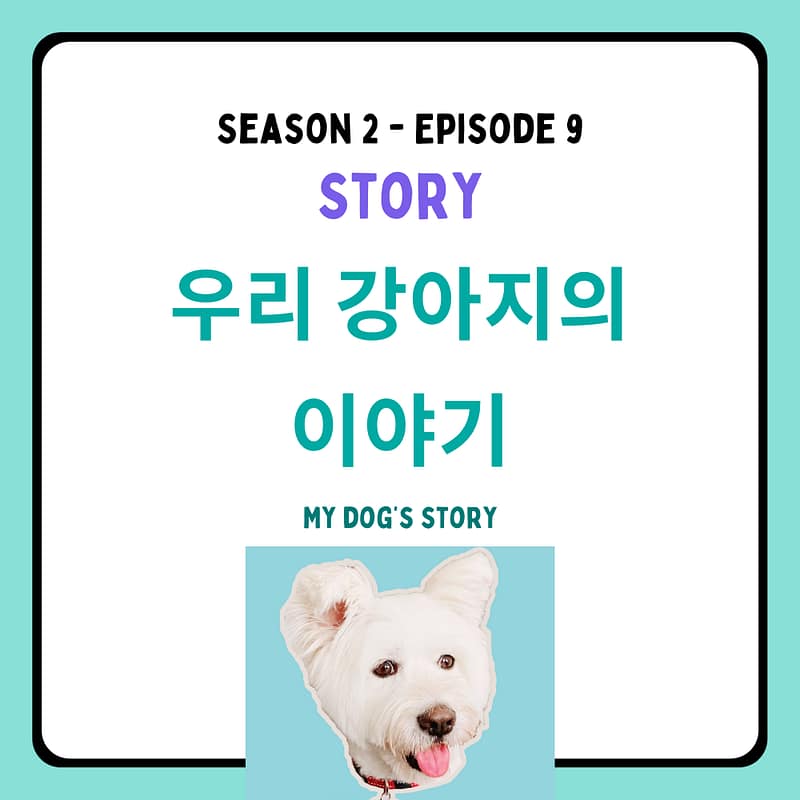Powered by RedCircle
시즌2, 9화. 이야기편 | 우리 강아지의 이야기
Season 2, Episode 9 – Story | My dog’s story
Today’s episode was created based on a request via Instagram from a listener with the user name “Ayeong.”
Also, this story is a real story about my dog named Mayo.
Then now, shall we listen to the story?
Transcript in Korean
저는 작년에 개 한 마리를 입양했어요. 우리 개 이름은 “마요”예요. 마요는 스페인어로 5 월이라는 뜻이에요. 우리 개 생일이 5 월이라서 “마요”라고 이름을 지어주었어요.
마요는 꽤 크지만 날씬해요. 그리고 털이 흰색이에요. 마요는 귀엽지만 소심해요.
사실 마요는 유기견이었어요. 어릴 때 여러 번 버려져서 사람을 싫어했어요. 처음에 저는 마요를 많이 좋아했지만 마요는 저를 싫어했어요. 하지만 이제는 마요도 저를 많이 좋아해요. 그래서 저는 정말 행복해요. 마요랑 같이 오래 살고 싶어요.
Translation in English
I adopted a dog last year. The dog’s name is “Mayo” Mayo means May in Spanish. My dog’s birthday is in May, so I named him “Mayo.” Mayo is quite large but slim, and the fur is white. Mayo is cute but timid.
Actually, Mayo was an abandoned dog. He disliked people because he was abandoned many times when he was young. At first, Mayo didn’t like me in the beginning, although I liked him a lot. But now, Mayo likes me a lot too. So I’m delighted. I look forward to living with Mayo for a long time.
How was it? Were you able to understand it? It was a story about a dog named Mayo.
All right, then, Now let’s break down some valuable expressions together.
저는 작년에 개 한 마리를 입양했어요. 우리 개 이름은 “마요”예요. 마요는 스페인어로 5 월이라는 뜻이에요. 우리 개 생일이 5 월이라서 “마요”라고 이름을 지어주었어요.
So basically, it’s about the introduction of the dog. I said in the story part that I adopted a dog last year, and the dog’s name is Mayo. and then I said 마요는 스페인어로 5월이라는 뜻이에요. Mayo means May in Spanish. For a language learner, there should be quite a lot of chances to use this expression when you try to explain what a certain word means in your language to a Korean. So you can use this expression and say “A word은/는 your language로 the meaning in Korean 라는/이라는 뜻이에요. If you know this kind of expression enough, the conversation with a native speaker would be much natural and easier.
And then lastly I said 우리 개 생일이 5 월이라서 “마요” 라고 이름을 지어주었어요 Since my dog’s birthday is in May, I gave him a name as Mayo. ~라고/이라고 이름을 지어주다 to give someone a name as ㅇㅇㅇ. It’s also a good expression to use. So please note that!
All right, then now let’s hear the next part.
마요는 꽤 크지만 날씬해요. 그리고 털이 흰색이에요. 마요는 귀엽지만 소심해요.
Well, as you heard, I explained how Mayo looks like. So there are many adjectives to describe him. In English or other languages born from Latin, when describing a subject such as a person, an animal, an object, we have to use the adjective with a verb “to be” ‘s conjugated form such as am, are, is, etc. For example, in this sentence, “a dog is big and slim,” all the adjectives big and slim were used with the verb “is”, right? In Korean, on the other hand, all the adjectives are already combined with the verb “to be”. For example, 커요 am/are/is big, 날씬해요 am/are/is slim. So you have to use it without using an extra verb and say 마요는 크지만 날씬해요. Mayo is big but slim. Also, this adjective can be used to decorate a noun like Mayo is a slim dog 마요는 날씬한 개예요. The word “Slim” is decorating a noun, a dog 개 here, right? In this kind of case, you can utilize the adjective verb to create the adjective form. For instance, 날씬하다 to be slim, the verb stem 날씬하 is not ending with 받침, so add ㄴ to it. Then the adjective form is completed like 날씬한. There are 3 fundamental rules when it comes to this conjugation. Like the verb 날씬하다, if the verb stem is not ending with 받침, then you can add ㄴ to the stem. But if the verb stem is ending with 받침, then you should add 은 like “to be small 작다” then the adjective form is 작은. And lastly, if the verb is ending with 있다 or 없다 like “맛있다 to be delicious”, you should take out 다 and add 는. However, I recommend you just memorize the conjugated verb form and the adjective form separately. Because many irregular verbs don’t follow the fundamental rules, I will upload a list of adjectives verbs in Korean showing conjugated verb form and the adjective form on our website “koreanstudycafe.com/podcast-scripts.” Take advantage of it!
For more information about Korean adjectives, scroll down
And then I also said 털이 흰색이에요 His fur is white. The word 털 is widely used in Korean. It can be used for animals, all of the human body parts. And we also have the word 머리카락. This word particularly indicates hair from humans’ heads. So you can’t use the word 머리카락 to an animal nor other parts of humans’ bodies. So keep a note of that.
All right, then lastly, let’s hear the rest part.
사실 마요는 유기견이었어요. 어릴 때 여러 번 버려져서 사람을 싫어했어요. 처음에 저는 마요를 많이 좋아했지만 마요는 저를 싫어했어요. 하지만 이제는 마요도 저를 많이 좋아해요. 그래서 저는 정말 행복해요. 마요랑 같이 오래 살고 싶어요.
Well… it seems like Mayo had such a hard life before being adopted by me, right? 사실 마요는 유기견이었어요. 어릴 때 여러 번 버려져서 사람을 싫어해요. In fact, Mayo was a rescue dog. When he was young, he was abandoned several times, so he didn’t like humans. Well, that’s a reasonable reason to hate humans for him, right?
He used to hate humans, including my family. During the first several weeks, he didn’t approach us. He always tried to keep a certain distance. But after a while, he got finally used to our house and family; he began to like us little by little 조금씩 저희를 좋아하기 시작했어요.
그래서 저는 정말 행복해요. So I am really happy—마요랑 같이 오래 살고 싶어요. I want to live long with Mayo. 마요랑 같이 with Mayo. The literal translation for this part is Mayo and together. But when these two words 랑 같이 are used together, then it means “with someone.” However, in Korean, there are many ways to say “and” and “together”. 하고, 랑/이랑, 와/과 means “and” when linking more than two nouns. Also, 같이, 함께 both means “together” in Korean. So as long as the word order is kept, any one of them can be paired with one of the counterparts. For example, it can be like this. 마요하고 같이, 마요랑 함께, 마요와 같이, 마요랑 함께. All of these combinations mean the same thing. Furthermore, the part meaning together can be omitted. It means if you say 마요하고, 마요와, 마요랑, it can also mean with Mayo as well. This is pretty complicating, right? So I will write the explanation with a table to make you understand better on our website. Therefore, if you want to see a detailed explanation, don’t forget to visit our website.
All right, this was about my dog Mayo. If you want to know more about Mayo, I will upload his Instagram address on this podcast’s description section. So go and see my Mayo and please give him a supportive comment for him 🙂
What are adjectives verbs in Korean?
In English or other languages born from Latin, adjectives are used like below
Subject + Verb + Adjective
i.e.) The dog is big, The dog is slim
In Korean, on the other hand, all the adjectives are already combined with the verb “To be (am/are/is, etc.)“. So they are used like below
Subject + Adjective verb
i.e.) 크다(be big), 날씬하다(be slim) / 강아지가 커요, 강아지가 날씬해요
How to conjugate Korean adjective verbs to the adjective forms
Also, this adjective can be used to decorate a noun like Mayo is a slim dog 마요는 날씬한 개예요. The word “Slim” is decorating a noun, a dog 개 here. In this kind of case, you can utilize the adjective verb to create the adjective form.
Then let’s see how to form the adjective form by using the verb.
Conjugation:
If the verb stem is ending with 받침(the consonant base), take out 다 and add 은
* 작다 (To be small)
Take out 다 and add 은
작 + 은 = 작은 (i.e. 작은 강아지 a small puppy )
Conjugation:
If the verb stem is ending WITHOUT 받침(the consonant base), take out 다 and add ㄴ
* 크다 (To be big)
Take out 다 and add ㄴ
크 + ㄴ = 큰 (i.e. 큰 강아지 a big puppy )
Conjugation:
If the verb is ending with 있다 or 없다, take out 다 and add 는
* 멋있다 (To be cool – appearance)
Take out 다 and add 는
멋있 + 는 = 멋있는 (i.e. 멋있는 강아지 a cool puppy )
However, I recommend you just memorize the conjugated verb form and the adjective form separately because many irregular verbs don’t follow the fundamental rules.






